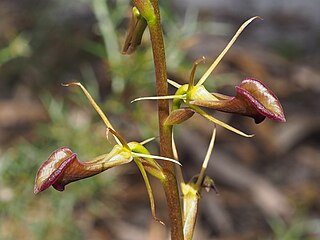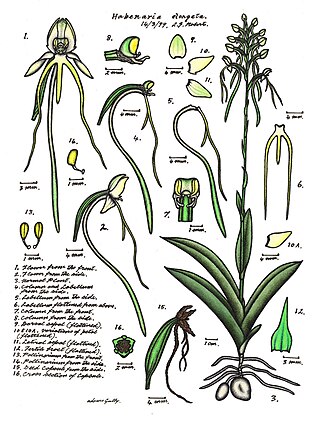
Cymbidium canaliculatum, commonly known as the channelled boat-lip orchid, tiger boat-lip orchid, native cymbidium or tiger orchid is a plant in the orchid family and is endemic to Australia. It is a clump-forming epiphyte with large, greyish green pseudobulbs, each with up to six curved, deeply channelled leaves and up to sixty fragrant, variably coloured flowers that often have spots and blotches and a white to cream-coloured labellum with red markings. This orchid usually grows in the forks or hollows of trees and is found from New South Wales to the northern parts of Western Australia.

Pheladenia deformis, commonly known as blue fairy orchid or blue beard is the only species of the flowering plant genus Pheladenia in the orchid family, Orchidaceae and is endemic to Australia. It was originally named as Caladenia deformis and has since had several name changes. Plants have a single, narrow, hairy leaf and usually blue flowers with relatively short, broad sepals and petals and an unusual labellum.

Caladenia latifolia, commonly known as pink fairies is a species of orchid endemic to Australia and is common and widespread in the southern half of the continent and in Tasmania. It has a single, hairy leaf and up to four pink flowers. It is easily distinguished by its relatively large, green leaf, and pink flowers on an unusually tall spike.

Cyrtostylis reniformis, commonly known as common gnat-orchid, is a species of orchid endemic to eastern Australia. It usually has a single kidney-shaped leaf and a flowering spike with up to eight reddish flowers with a shelf-like labellum.

Diuris sulphurea, commonly called the tiger orchid or hornet orchid, is a species of orchid which is endemic to eastern Australia. It has up to three leaves, and a flowering stem with up to seven bright yellow flowers with dark brown markings.

Diuris longifolia, commonly known as purple pansy orchid, is a species of orchid that is endemic to the south-west of Western Australia. It has up to three linear leaves and up to seven purple and mauve flowers with yellowish markings from September to November.

Caladenia flava subsp. flava, commonly known as the cowslip orchid, is a species of orchid endemic to the south-west of Western Australia. It is a relatively common orchid with a single, hairy leaf and up to three golden-yellow flowers which often have red markings.

Caladenia flava subsp. maculata, commonly known as the Kalbarri cowslip orchid, is a species of orchid endemic to the south-west of Western Australia. It has a single, hairy leaf and up to three lemon-yellow flowers with brownish-fawn spots on some parts. It mainly occurs in near-coastal areas north of Geraldton.

Caladenia flava subsp. sylvestris, commonly known as the karri cowslip orchid, is a species of orchid endemic to the south-west of Western Australia. It has a single, hairy leaf and up to three pale yellow and cream-coloured flowers which are white near the tips of the sepals and petals and marked with bright red or pink.

Diuris alba, commonly called the white donkey orchid, is a species of orchid which is endemic to eastern Australia. It has up to three leaves, and a flowering stem with up to seven white flowers with purplish markings.

Prasophyllum gibbosum, commonly known as the humped leek orchid, is a species of orchid endemic to the south-west of Western Australia. It is a late-flowering leek orchid with a single smooth, tubular leaf and up to eighty or more purplish-red and white flowers with a smooth labellum. It is similar to P. cucullatum but that species has a frilly labellum, usually a shorter flowering stem and an earlier flowering period.
Prasophyllum macrostachyum, commonly known as the laughing leek orchid, is a species of orchid endemic to the south-west of Western Australia. It has a single smooth, tube-shaped leaf and up to thirty yellowish-green and purple flowers. It is one of the few Western Australian leek orchids which is not stimulated by summer fires and also has an unusually long flowering period.
Microtis pulchella, commonly known as the beautiful mignonette orchid or beautiful onion orchid, is a species of orchid endemic to the south-west of Western Australia. It has a single hollow, onion-like leaf and up to twenty five white, thinly textured flowers with a slight perfume. It only flowers after fire and only sometimes produces short, thread-like leaves in the absence of fire.

Diuris pedunculata, commonly known as the small snake orchid, is a species of orchid which is endemic to New South Wales. It usually has two leaves at its base and one or two yellow and orange flowers with purple markings. It originally occurred in scattered populations between Tenterfield and the Hawkesbury River but because of habitat loss is now only known from the New England Tableland.

Diuris setacea, commonly called the bristly donkey orchid, is a species of orchid that is endemic to the south-west of Western Australia. It has a tuft of up to ten twisted leaves at its base and up to seven yellow flowers with a few brown markings. It grows in moist soil on granite outcrops and flowers much more prolifically after fire the previous summer.

Thelymitra canaliculata, commonly called the flushed sun orchid or blue sun orchid is a species of orchid in the family Orchidaceae and is endemic to the south-west of Western Australia. It has a single erect, fleshy leaf and up to twenty eight blue flowers with darker veins and sometimes flushed with pink. The lobe on top of the anther is blackish with a yellow crest.
Thelymitra tigrina, commonly called the tiger orchid or tiger sun orchid, is a species of orchid that is endemic to the south-west of Western Australia. It has a single narrow leaf and up to fifteen small yellow flowers with small brown spots.

Cryptostylis ovata, commonly known as slipper orchid or western tongue orchid, is an orchid endemic to Western Australia. It is a common, summer flowering species with dark green leaves with a white central vein and up to fifteen pale greenish flowers with a brownish red labellum with a network of darker veins.

Habenaria elongata, commonly known as the white rein orchid, or Kimberley spider orchid, is a species of orchid that is endemic to northern Australia. It has up to four leaves at its base and up to twenty small white flowers with yellowish tips and thread-like lobes on the labellum.

Habenaria ochroleuca, commonly known as the sickle orchid or sickle habenaria, is a species of orchid that is endemic to northern Australia. It has two or three broad, glabrous leaves and up to twenty five white flowers on a flowering stem with many overlapping bracts. The side lobes of the labellum curve upwards.

















